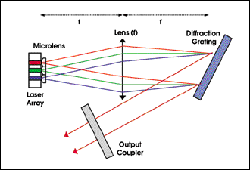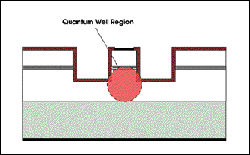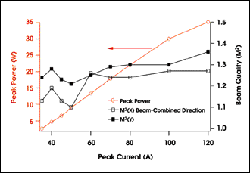
Small Smile Produces Big Output from SCOWLs
Breck Hitz
Researchers at Massachusetts Institute of Technology's Lincoln Laboratory in Lexington have combined the beams from 100 slab-coupled optical waveguide lasers (SCOWLs) to generate 35 W of near-diffraction-limit output power at 915 nm. The high beam quality was possible in part because the array of semiconductor lasers had a small smile, a deviation from the flatness across the array.
High-power, high-beam-quality semiconductor lasers are valuable as optical pumps for bulk solid-state and fiber lasers, and they have many other industrial, metrological and medical applications. Because the diffraction-limited power from a single laser is limited to several watts, laboratories worldwide have investigated beam-combining techniques to generate larger outputs. Coherent combining is one technique, in which the wavelengths and phases of multiple sources are locked together so that they interfere constructively.

Figure 1. The intracavity grating locks the wavelength of each emitter to the appropriate wavelength for efficient combining. The beams, each at a different wavelength, are combined into a single beam at the output mirror. Image ©OSA.
An alternative, perhaps more straightforward, procedure is spectral combining, in which the sources lase at different wavelengths and are spatially combined with a diffractive element, such as a prism or grating. This was the technique used by the team at Lincoln Laboratory.
The researchers placed their beam-combining grating inside the resonator, thereby locking the wavelength of each element to the correct value for efficient combining (Figure 1). The 100 SCOWLs in the array were spaced at a 100-µm pitch and operated quasi-CW with a 1 percent duty cycle. The front facet of the array was antireflection-coated -- <1 percent reflectivity --, and the output coupler reflected 10 percent of the incident power back toward the grating.
SCOWLs, which the researchers developed several years ago, feature a rib waveguide that produces a nearly circular output beam of near-diffraction-limited quality (Figure 2). By fabricating the lasers in a monolithic array, the scientists ensured that the combined beam would likewise be near-diffraction-limited.

Figure 2. A slab-coupled optical waveguide laser features quantum wells in a rib waveguide and produces a nearly circular, near-diffraction-limited output beam.
When they measured the beam quality of their combined-beam laser, they found a slightly higher M2 (<1.35 in each direction) than for the individual SCOWLs (~1.1 in each direction). The degradation in the beam-combining direction along the array was probably due to positioning errors on the grating. In the perpendicular direction, the degradation resulted from the small but nonzero smile of the array.
The beam quality was relatively constant over all operating ranges, and the peak power reached a maximum of 35 W (Figure 3). The researchers predict that much higher powers could be achieved by increasing the number of elements and the power from each. They envision 12 arrays, each containing 200 1-W SCOWL emitters.

Figure 3. The combined-beam laser produced 35 W of peak power with an M2 value of less than 1.35 in each direction.
If such a device could achieve a combining efficiency of ~85 percent, which they think is reasonable, it would produce 2 kW of near-diffraction-limited power in a 36-nm bandwidth. Finally, polarization multiplexing of two such devices could produce 4 kW of near-diffraction-limited output.
Published: September 2005